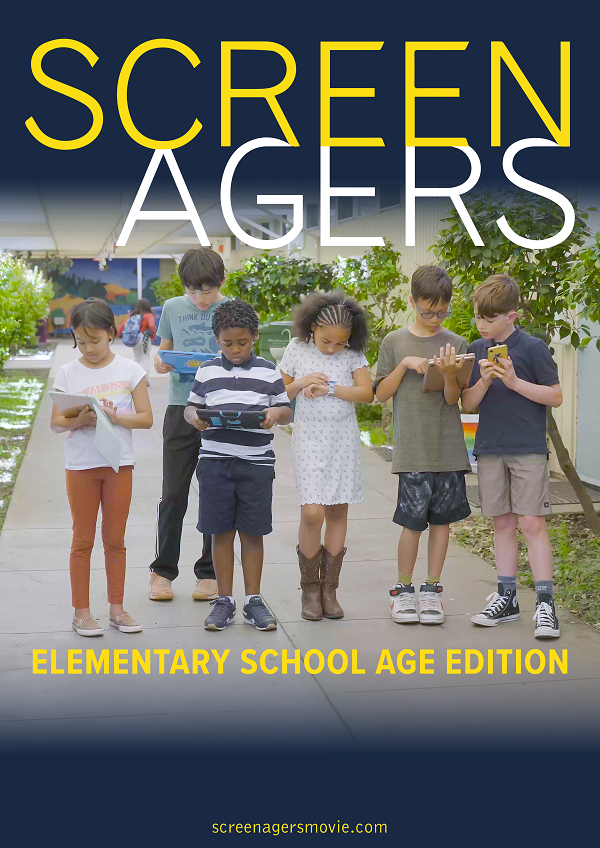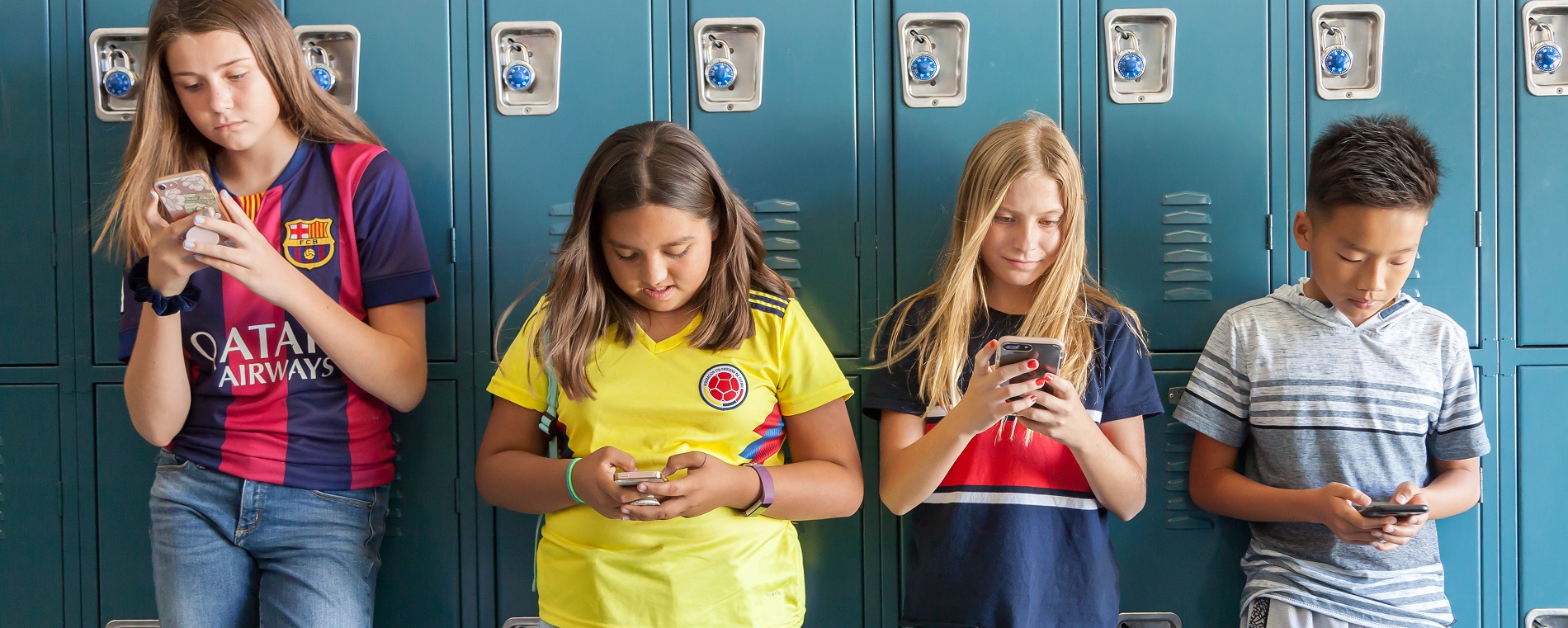Digital media is all around us. We use it for a variety of daily activities - school, work, social networks, email, shopping, watching movies, playing games, getting the news, connecting with friends and family, and more. It is no wonder that people acquire their digital media practices and interests at a young age. With ever-increasing options, it is important for all of us, including children and teens, to apply practical strategies to incorporate safety, balance and self-management.
Upcoming Events

Join us for a Free Movie Screening of "Screenagers: Elementary School Age Edition"
Beach Cities Health District (BCHD) and South Bay Families Connected are partnering with Hermosa Beach City School District, Manhattan Beach Unified School District and Redondo Beach Unified School District to host community showings of the documentary, “Screenagers: Elementary School Age Edition,” the new version of the original Screenagers movie that addresses issues that elementary school aged kids, parents and educators are facing – smartwatches in class, unhooking from and monitoring video gaming, social media pressures and exposure too young. This screening and discussion is intended for parents and caregivers to learn about existing research around these topics and potential solutions to these and other challenges in order to address and support mental well-being in the digital age.
South Bay parents and caregivers are welcome to attend any event date. Free childcare offered by Adventure Plex staff. Find more information on the registration form.
MANHATTAN BEACH
Meadows Elementary School
1200 N. Meadows Ave., Manhattan Beach
Tuesday, April 29, 5:30 – 7 p.m.
Grand View Elementary School
2617 Bell Ave., Manhattan Beach
Thursday, May 8, 5:30 – 7 p.m.
HERMOSA BEACH
Hermosa View Elementary School
1800 Prospect Ave., Hermosa Beach
Tuesday, May 13, 5:30-7 p.m.
The impact of digital media on youth mental health is influenced by a variety of complex factors, including, but not limited to, the type and quality of content, the length of time spent and the degree to which sleep, physical activity, schoolwork and in-person socializing is disrupted. In addition, we all have unique traits, interests, personalities and experiences that affect our relationship(s) with screens.
Scientific research indicates a mixed bag of results on the effects of digital media on youth. On the one hand, digital media can bring enjoyment and skills. It can help young people socialize, build community and gain knowledge. Social media can provide a space for self-expression and online support. Playing video games can improve fine motor skills and teamwork. On the other hand, research and testimonies show that social media can lead to harassment, cyberbullying, exploitation and exposure to content that worsens mental health issues. According to the Journal of the American Medical Association (JAMA), too much screen time for children can negatively impact attention, academic performance, obesity and behavior.
In May 2023, the United States Surgeon General released the U.S. Surgeon General's Advisory on Social Media and Youth Mental Health. “With adolescence and childhood representing a critical stage in brain development that can make young people more vulnerable to harms from social media, the Surgeon General is issuing a call for urgent action by policymakers, technology companies, researchers, families, and young people alike to gain a better understanding of the full impact of social media use, maximize the benefits and minimize the harms of social media platforms, and create safer, healthier online environments to protect children.”
Know the Facts
- As reported in 2023 in the U.S. Surgeon General's Advisory on Social Media and Youth Mental Health:
- Up to 95% of youth between the ages of 13 to 17 report using a social media platform, with more than a third saying they use social media almost constantly.
- As of 2021, 8th and 10th graders now spend an average of 3.5 hours per day on social media.
- Despite most social media platforms having a minimum age requirement of 13 years old, nearly 40% of children ages 8-12 use social media.
- As reported in 2023 in Teens, Social Media and Technology 2023 | Pew Research Center:
- 95% of teens have or have access to a smartphone, 90% to a computer, 83% to a gaming console and 65% to a tablet.
- YouTube (93%), TikTok (63%), Snapchat (60%) and Instagram (59%) remain popular among teens ages 13 to 17. BeReal (13%) is increasing in popularity and Facebook (33%) and X (20%), formerly Twitter, is decreasing.
- Teen girls are more likely than teen boys to report using Instagram (66% vs. 53%). BeReal, TikTok, Snapchat and Facebook also are more commonly used by teen girls.
- Teen boys are more likely than teen girls to use Discord (34% vs. 22%) and Twitch (22% vs. 11%). Also, a larger share of boys than girls use Reddit and YouTube.
- More Black teens (80%) report using TikTok compared with Hispanic teens (70%) and White teens (57%).

- From the California Healthy Kids Survey:
- California
- In 2023, 23% of 5th graders reported experiencing some level of cyberbullying in the past 30 days.
- Los Angeles County
- In 2023, 30% of 7th graders, 19% of 9th graders and 17% of 11th graders reported experiencing some level of cyberbullying in the past 30 days.
- Beach Cities
- In 2024, nearly 20% of Beach Cities 5th graders reported experiencing some level of cyberbullying in the past 30days.
- California
Take Action
There are actions parents and youth can take now to engage in positive use of digital media and develop healthy habits.
What Parents and Caregivers Can Do
- Create a family media plan. Families can build a media plan using a tool designed to set guidelines and create an agreement about digital media use for the household. As we are all unique, your plan will be too. To start your family media plan, visit the American Academy of Pediatrics. Additional options are below in “Helpful Links.”
- Learn about digital media and technology as much as you can. You can start with Common Sense Media and some of the other websites in the “Helpful Links” section.
- Model digital citizenship and be mindful of what your kids see you doing.
- Teach your children about digital technology and empower them to be responsible online participants.
- Keep personal information private and show your children how to do the same. Set ground rules around whom children can engage with online and enable privacy settings to help support safe online experiences.
- Be empathetic, thoughtful and considerate in what you post, share and comment on.
- Discuss why you choose to follow some things and not others.
- Report cyberbullying and online abuse and exploitation.
- Balance time with and without digital devices. Create tech-free zones and encourage your kids to have in-person activities and friendships.
- Discuss social media with your children and regularly check in. The American Academy of Pediatrics’ Center of Excellence for Social Media and Youth Mental Health offers a variety of Conversation Starters by Topic and Age. The resource list below includes additional options.
- Connect with other parents to create an environment that supports healthy social media use in your community.
- Be aware of signals that warn of problematic online use, such as withdrawing from previously enjoyed activities or changes in eating and sleep patterns.
What Youth Can Do
- Take breaks from social media, including deactivating social media accounts, setting limits on your follower count, and archiving or changing privacy settings on your pictures/account so that only you can see your content.
- Cut down on distractions by keeping apps on silent and/or turning off app notifications.
- Learn how much time you spend on screen time, such as social media, searching the Internet and playing games. By tracking how you spend time on your phone/social media, you can ask yourself about what is meaningful to you and what you could spend less time doing. Ironically, there may be apps to help you do this!
- Balance how much time you spend online with time seeing your friends, engaging in activities and being social in real life.
- Prioritize your time. Decide which groups (such as accounts/communities centered on ethnic, cultural, hobby, educational, linguistic or other interests) are most important for you to participate in at one time. This may help you to better manage your time and experience on social media.
- Find the joy. Follow online communities or causes that you identify with and engage with people that make you feel seen and provide support and positivity.
- Remove people or social media accounts who do not show you respect, and who do not make you feel good about yourself.
- Protect yourself and others from cyberbullying or other forms of online harassment and abuse. If you or someone you know is the victim of cyberbullying or other forms of online harassment and abuse, don’t keep it a secret.
- Protect others by not taking part in online harassment or abuse.
- Avoid forwarding or sharing messages or images, tell others to stop, and report offensive content.
(Source: Substance Abuse and Mental Health Services Administration, 2019)
If you or someone you know is being negatively affected by social media, reach out to a trusted friend or adult for help. If you or someone you know is experiencing a mental health crisis, call or text 988 for immediate help.
Helpful Links
Online Tools and Conversation Starters for Creating Media Plans
- BCHD’s Family Media Plan sheet
- Parental Controls Cheat Sheet
- Family Media Plan from the American Academy of Pediatrics (AAP) is an interactive online tool that allows you to customize a set of media guidelines that works for your family.
- Media Use Guidance: Age-Based Tips inform parents about their children’s developmental stages, how this influences media use, and healthy media habits to strive for at home.
- Your Child’s First Phone: Are They Ready?
Additional Resources
- The U.S. Surgeon General's Advisory: Social Media and Youth Mental Health
- Center of Excellence on Social Media and Youth Mental Health serves as a centralized source for evidence-based education and technical assistance to support the mental health of children and adolescents as they navigate social media.
- Managing Technology & Social Media in Healthy Ways — Families Connected (southbayfamiliesconnected.org)
- Common Sense Media supports families with tips and advice on social media, parental controls, screen time, internet safety, and much more.
- NetSmartz provides age-appropriate videos and activities to help teach children to be safer online.
- AAP Online Health & Safety Resources offers information about digital literacy, cyberbullying, parental controls, and related topics.
- Digital Citizenship is a tip sheet from Beach City Health District’s “Talk About It” series.
Legislation




